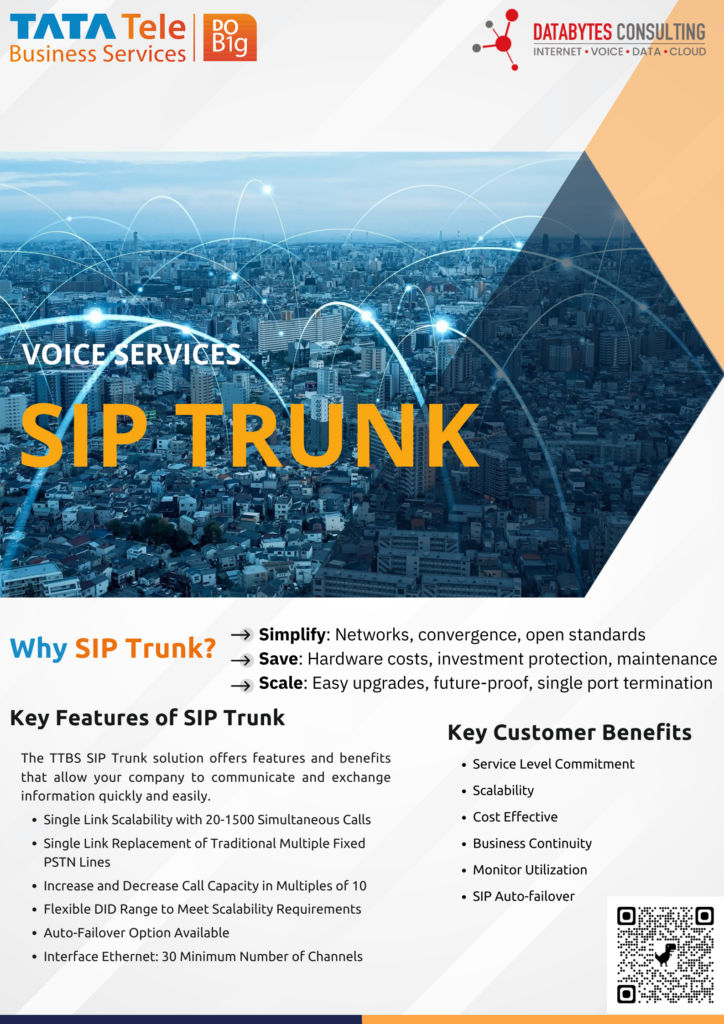Blogs
Comprehensive Guide to SIP Trunking

What is SIP Trunking?
Session Initiation Protocol (SIP) trunking is a digital method that allows for making and receiving phone calls and other forms of digital communication over the internet. The key feature of SIP trunking is its ability to use virtual phone lines for these communications.
The Rise of Digital Communication
With advancements in technology, communication methods have evolved rapidly. Digital communication, especially SIP trunking, has become a preferred choice for many businesses due to its efficiency and cost-effectiveness.
From telegraphs to tweets, the realm of communication has seen a dramatic shift. Digital communication, with its speed, efficiency, and innovation, has revolutionized our world. As we stride into the future, one can only wonder, “What’s next?” But one thing’s for sure; as long as humans exist, the desire to communicate will never fade.
The Impact on Business and Society
- Speed and Efficiency in Business Communication
On a serious note, digital communication revamped business dynamics. Deals were made on Skype calls, and contracts were sent via emails. Efficiency and speed became the new mantra.
- Cultural Shifts and Globalization
On a broader spectrum, the world became a global village. Cultures intertwined, and boundaries blurred. Remember watching that foreign series with subtitles? That’s digital communication bridging cultural gaps!
The Future of Digital Communication
Now, as we stand at the brink of further advancements, augmented and virtual reality promise an even more immersive communication experience. Imagine having a business meeting in a virtual tropical paradise. Exciting, isn’t it?
SIP Trunking vs Traditional Phone Lines
Unlike traditional phone lines that use physical lines, SIP trunking utilizes the internet for communication, making it more scalable and reliable.
How SIP Trunking Works
SIP Trunking involves routing phone calls over the internet using the Session Initiation Protocol. It is an advanced method that bypasses traditional telephony systems to provide seamless communication.
Routing Calls Over the Internet
Phone calls made through SIP Trunking are converted into data packets and sent over the internet. This provides clearer voice quality and quicker connections.
The Role of Internet Telephony Service Providers
Internet Telephony Service Providers (ITSPs) play a crucial role in SIP trunking. They ensure the smooth transmission of data packets over the internet and provide connectivity between the SIP trunking system and traditional phone lines.
Benefits of Using SIP Trunks Over T1 Lines
While T1 lines were once the gold standard for business communications, SIP trunks have emerged as a more cost-effective and scalable solution. They offer greater flexibility, better voice quality, and easy integration with other communication tools.
Certainly! SIP Trunking and T1 lines are both communication technologies, but they differ in various aspects. When it comes to choosing between the two, many businesses are leaning towards SIP Trunks due to several advantages. Here are the primary benefits of using SIP Trunks over T1 lines:
- Cost-Efficiency : Lower Monthly Costs: SIP Trunking generally offers lower monthly service costs compared to T1 lines. Reduced Long-Distance Charges: SIP providers often have competitive rates for long-distance and international calls, potentially leading to significant savings.
- Scalability : Easy Expansion: With SIP Trunks, it’s easier to scale up or down based on your business needs. There’s no need to add physical lines as you can increase or decrease channels virtually. Only Pay for What You Use: Unlike T1 lines that have a fixed number of channels, with SIP Trunks, you often have the flexibility to pay for only the channels or capacity you need.
- Flexibility : Integration with Other Systems: SIP Trunking can be seamlessly integrated with various PBX systems and unified communication solutions. Location Independence: With SIP, you’re not tied to a geographic location. This is ideal for businesses with multiple sites or remote workers.
- Reliability : Built-in Redundancy: Many SIP Trunk providers offer redundancy, meaning if one path fails, the communication is rerouted, ensuring business continuity. Faster Recovery: In the event of outages, SIP solutions can quickly reroute calls, minimizing downtime.
- Enhanced Call Quality: High Definition (HD) Voice: Many SIP Trunks support HD voice, which provides clearer, more natural-sounding voice communication compared to standard T1 lines.
- Modern Technology: Future-Ready: As the world gravitates towards IP-based communication, SIP Trunks are more in line with current technological trends and are more future-proof than T1 lines.
- Rich Features : Advanced Communication Features: Beyond voice, SIP Trunks can support video, instant messaging, and other unified communication features.
- Simplified Infrastructure: Less Physical Equipment: SIP often requires less on-premises equipment, leading to reduced maintenance and management overhead.
- Unified Data and Voice: SIP Trunks allow for the convergence of voice and data over the same connection, streamlining the network infrastructure.
- Direct Inward Dialing (DID): More Numbers with Less Infrastructure: With SIP Trunks, businesses can have a vast number of DID numbers without needing separate physical lines for each, facilitating direct, person-to-person communication.
- Enhanced Security Encryption: Many SIP providers offer end-to-end encryption options to ensure secure voice communication. Protection against Threats: With the right setup and precautions, SIP Trunks can be fortified against potential threats and attacks.
SIP Trunk Providers and Their Services
There are numerous SIP trunk providers in the market, each offering unique services and features.
Leading Providers in the Market
Some of the renowned SIP trunk providers include Tata Tele, VI,Twilio, Nextiva, and RingCentral. Each provider offers different pricing plans and features to cater to various business needs.
Selecting the Right SIP Trunk Provider for Your Needs
When choosing a SIP trunk provider, consider factors such as pricing, features, customer support, and scalability.
Selecting the Right SIP Trunk Provider for Your Business Needs
The digital era has brought with it a variety of communication options for businesses. Among these, SIP trunking stands out as one of the most efficient and cost-effective methods. Essentially, SIP trunking routes phone calls over the internet using the Session Initiation Protocol, offering businesses clearer voice quality, swift connections, and scalability.
However, like with many technological services, there’s no one-size-fits-all provider. Selecting the right SIP trunk provider for your business is crucial for optimal performance, cost savings, and overall communication experience. Here’s a guide to help you navigate this selection process:
- Understand Your Business Needs:
Before diving into the vast market of SIP trunk providers, assess your business requirements. How many lines do you need? What call volume do you expect? Do you need international calling? Understanding your needs is the first step to finding a suitable provider.
- Pricing and Cost Effectiveness:
Price should be transparent without hidden costs. While affordability is essential, remember that the cheapest option might not always be the best in terms of quality and reliability. Also, consider looking for providers that offer flexible pricing plans, allowing you to scale up or down based on your requirements. - Features and Add-Ons:
Beyond basic SIP trunking, many providers offer additional features such as call recording, voicemail-to-email, call analytics, and more. Determine which features are essential for your business and which are nice-to-have. - Reliability and Uptime:
Downtime can be costly for businesses. Hence, ensure that the provider you choose has a good track record of uptime. Many top-tier providers offer 99.9% uptime, ensuring that your communication lines are almost always up and running. - Customer Support:
24/7 customer support can be a lifesaver, especially if you face issues during non-business hours. The quality of customer support – their responsiveness, expertise, and approachability – can make a significant difference in your overall experience. - Scalability:
Your business might grow, or you might have seasonal spikes in call volume. The provider you select should be able to scale with you, accommodating both upward and downward shifts in requirements without cumbersome processes or excessive costs. - Security and Compliance:
Ensure that the provider follows stringent security protocols and complies with industry regulations. Encrypted communication, fraud prevention measures, and regular security audits are some features to look for. - Reviews and Recommendations:
Lastly, don’t forget to check reviews from other businesses. Personal recommendations can also be invaluable in providing insights into a provider’s real-world performance.
Conclusion:
Selecting the right SIP trunk provider is crucial for ensuring seamless communication for your business. By carefully considering the factors mentioned above, you can choose a provider that not only meets your current needs but also aligns with your future growth and changes. Always remember, the right partnership will not only save costs but also enhance your business communication manifold.
SIP Trunking vs. Other Technologies
SIP Trunking is often compared with other communication technologies. Understanding these comparisons can help businesses make informed decisions. For business owners comparing different communication technologies, our in-depth analysis can help you determine if SIP trunking is the right fit for you. Certainly! SIP Trunking is a technology that is often compared to other telecommunication methods. Here’s a breakdown of SIP Trunking versus other common technologies:
SIP Trunking vs. PSTN (Public Switched Telephone Network)
Scalability: SIP Trunking is easily scalable, allowing businesses to add or reduce lines as needed. PSTN requires physical lines for each connection.
Cost: SIP often offers cost savings, especially for long-distance or international calls. PSTN can be more expensive for such calls.
Infrastructure: SIP uses IP (Internet Protocol) to transmit voice, while PSTN uses circuit-switched telephony.
SIP Trunking vs. PRI (Primary Rate Interface)
Flexibility: SIP offers more flexibility, as it’s not bound to a specific number of channels like PRI (which has 23 voice channels and 1 data channel). Deployment Speed: SIP can be deployed faster since it’s virtual, while PRI requires physical lines. Maintenance: SIP can be maintained and troubleshot remotely, whereas PRI might require on-site visits.
SIP Trunking vs. VoIP (Voice over Internet Protocol)
Function: While both use IP to transmit voice, SIP Trunking specifically refers to the protocol to establish, modify, and terminate multimedia sessions, whereas VoIP is a broad term for voice over IP technology.
Integration: SIP Trunking can be easily integrated with other business systems, whereas VoIP is primarily focused on voice transmission.
Usage: SIP Trunking is often used for larger businesses with its capability to handle vast amounts of simultaneous calls, while VoIP can be used for both individual and business needs.
SIP Trunking vs. ISDN (Integrated Services Digital Network)
Technology Base: ISDN is an older technology, relying on digital circuit-switched telephony, whereas SIP is more modern and uses packet-switched telephony.
Cost Efficiency: SIP typically offers better rates and cost efficiency, especially as ISDN services are being phased out in many places.
Bandwidth: SIP is more efficient in its use of bandwidth, offering better call quality with the same or even less bandwidth compared to ISDN.
SIP Trunking vs. Analog Lines
Quality: SIP, being a digital technology, often offers clearer voice quality than analog lines.
Features: SIP Trunking can support advanced features like video conferencing, instant messaging, and multimedia transmission, which are not possible with traditional analog lines.
Reliability: While both can be reliable, SIP can offer redundancy options that ensure continued service even if one route or connection fails.
In conclusion, while each technology has its merits, SIP Trunking stands out for its flexibility, scalability, and cost-efficiency, making it a preferred choice for many modern businesses.
Moving from PSTN to SIP Trunking
With the decline of the traditional Public Switched Telephone Network (PSTN), many businesses are transitioning to SIP trunking for more advanced features and reduced costs.
Benefits and Advantages of SIP Trunking
Why should business owners consider SIP trunking? Uncover the myriad benefits, from cost savings to enhanced call features, that make it an attractive option. SIP Trunking offers numerous benefits that make it an attractive option for businesses.
- Cost Savings : Reduced Call Costs: SIP Trunking typically offers competitive rates, especially for long-distance and international calls, which can result in significant savings.
Elimination of Physical Infrastructure: No need for physical lines, leading to reduced maintenance costs and the removal of a traditional PBX system.
- Scalability and Flexibility: Easy Scaling: Businesses can quickly scale up or down based on their needs. You can add channels or lines as required without significant infrastructure changes. Seasonal Adjustments: Perfect for businesses with seasonal spikes, allowing them to adjust their communication requirements accordingly.
- Improved Reliability: Built-in Redundancy: Many SIP providers offer failover provisions, ensuring that if one route fails, the communication is rerouted through another path. Uptime: High uptime guarantees mean minimal disruptions to business operations.
- Enhanced Quality: HD Voice: SIP Trunking supports High Definition (HD) voice, resulting in clearer, more natural-sounding calls. Better Performance: Reduced latency, jitter, and packet loss, leading to superior call quality.
- Advanced Features: Unified Communications: Easily integrate SIP with other communication tools like video conferencing, instant messaging, and screen sharing. Mobility: Many SIP solutions offer mobile integration, allowing employees to stay connected wherever they are.
- Streamlined Management: Centralized Control: Manage multiple locations or systems through a centralized interface, simplifying administration. Detailed Reporting: Access to detailed call analytics and reports for better decision-making.
- Business Continuity: Disaster Recovery: In case of local outages, calls can be rerouted to other locations or mobile phones, ensuring uninterrupted business operations. Geographical Independence: Operate from anywhere, making it easier to move offices or set up remote work solutions without changing phone numbers or systems.
- Eco-friendly: Reduced Carbon Footprint: Less physical infrastructure means less energy consumption and fewer resources used in production and maintenance.
- Integration and Interoperability: Compatibility: SIP Trunking can be integrated with various PBX systems and business applications, ensuring seamless communication.
- API Access: Many providers offer API access for custom integrations, enhancing business processes.
- Secure Communication: Encryption: Calls can be encrypted, ensuring that sensitive business information remains confidential. Regular Updates: As it’s a digital system, SIP Trunking can be updated regularly to address vulnerabilities, ensuring a secure communication environment.
Future of SIP Trunking
As technology continues to evolve, SIP trunking will likely undergo further advancements, making it even more beneficial for businesses.
Stay ahead of the curve. Learn about the emerging trends and the promising future of SIP trunking, ensuring your business remains at the forefront of digital communication.
Emerging Trends in Digital Communication
With the rise of AI and machine learning, we can expect even more innovative features in SIP trunking systems.
The Role of SIP Trunking in Unified Communications
SIP trunking will play a pivotal role in unified communications, allowing businesses to integrate various communication tools into a single platform.


